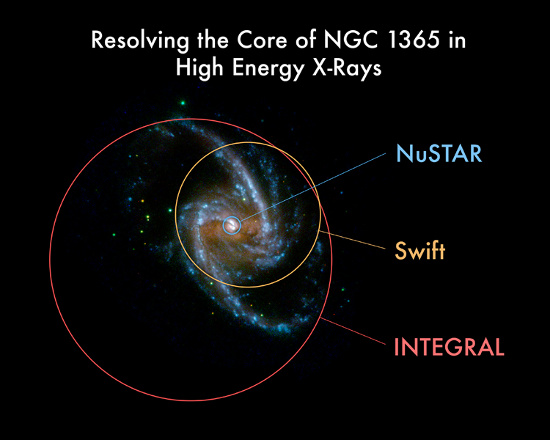The supermassive black hole rotates at the speed of light
For the first time astronomers have measured the rotation speed of a supermassive black hole, and it rotates at nearly the speed of light.

Images of NGC 1365 show NuStar's ability to take close-up shots of black holes
NuStar, the US Department of Aviation and Space's X-ray telescope telescope (NASA) has been orbiting in mid-last year, providing the latest evidence that the outer edge of the black hole NGC 1365 is spinning at velocity. 84% speed of light or more.
Galaxy galaxy black hole NGC 1365 has more than 2 million times the mass of the sun, so astronomers cannot imagine it turning so fast.
Professor Guido Risaliti of the Harvard-Smithsonian Center for Astrophysics (USA) and his colleagues draw their conclusions when studying high-energy rays through NuStar and Europe's XMM-Newton space telescope. .
According to the Nature report, the outer edge of the black hole NGC 1365 has a rotational speed ranging from 84 to 97% of the speed of light.
Measuring the rotation speed of black holes at galactic centers attracts special attention from astronomers, since their representations are thought to reflect the formation of the galaxy itself.
- Super-large black hole rotates rapidly near the speed of light
- The supermassive black hole closest to Earth glows intensely
- Researchers are about to film a supermassive black hole
- First determine the rotation speed of the black hole
- Video: Compare the size of black holes in the universe
- The supermassive black hole in the center of the Milky Way is 'hungry' like never before
- Detecting the supermassive black hole is spraying material
- The three galaxies unite to
- The mystery of a quick gust at the supermassive black holes
- Super black holes bombard the Earth with powerful cosmic rays
- Monster black hole 'belching' twice after swallowing gas
- The first time I took a picture of a black hole three million times bigger than Earth
 Van Allen's belt and evidence that the Apollo 11 mission to the Moon was myth
Van Allen's belt and evidence that the Apollo 11 mission to the Moon was myth The levels of civilization in the universe (Kardashev scale)
The levels of civilization in the universe (Kardashev scale) Today Mars, the sun and the Earth are aligned
Today Mars, the sun and the Earth are aligned The Amazon owner announced a secret plan to build a space base for thousands of people
The Amazon owner announced a secret plan to build a space base for thousands of people